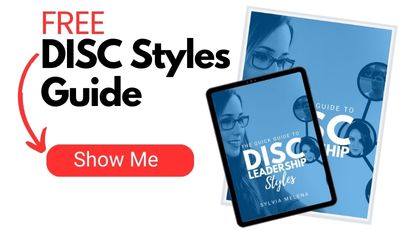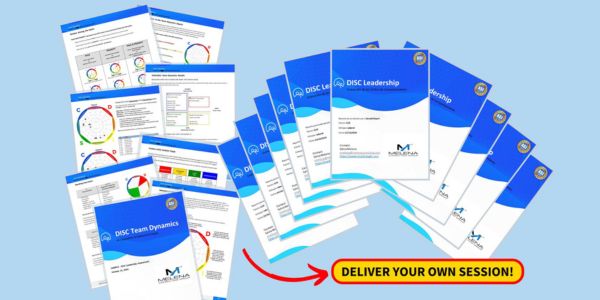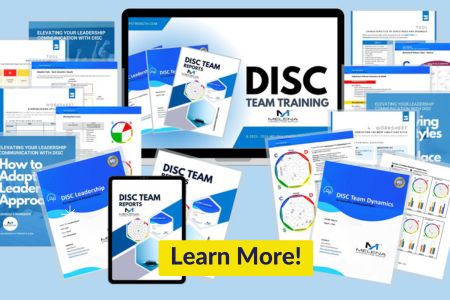Only 25% of respondents say their organizations’ leaders are engaged, are passionate, and inspire employees to the best-possible extent.
Patrick Guggenberger, Dana Maor, Michael Park, & Patrick Simon in McKinsey & Company 1
It’s true.
Only 25% of leaders are living up to their full potential.
But it doesn’t have to be this way.
Organizations can leverage the DISC Model to engage, equip, and empower their leaders to bring their best.
What is DISC Training?
The DISC assessment helps people understand their communication and behavioral tendencies according to the four DISC styles of leadership communication that comprise the acronym DISC:
- D – Dominance
- I – Influence
- S – Steadiness, and
- C – Conscientiousness

DISC training, anchored in the DISC assessment, is a popular workplace development resource used by millions of leaders worldwide.
Vital Elements of Effective DISC Training
However, for DISC leadership and team development sessions to be effective, they must include the following core requirements:
- A valid and reliable DISC assessment,
- Qualified and skilled DISC facilitators, and
- Effective curriculum in alignment with sound adult learning principles.
The DISC talent development programs and materials provided by Melena Consulting Group meet all these requirements.
DISC Provides Significant Benefits
Organizations worldwide deploy DISC for leadership and talent development because it’s a simple, evidence-based model that yields significant results. But before I share how your organization or clients can benefit from incorporating DISC into your talent development programs, I would like to share a huge caveat.
DISC is Not a Cure-All
DISC is not a cure for all the organization’s leadership and team challenges. I would be remiss if I didn’t share this caveat with you.
Unfortunately, I have received my fair share of training requests when stand-alone training as an intervention was not the answer. The best course of action for each client is another topic.
However, if there’s a performance improvement concern, DISC training, or any training for that matter, may or may not be part of the solution. A solid needs assessment is required to determine the best strategy and tactics for the situation.
That said, I also get contacted by organizational leaders and consultants who have already conducted an in-depth analysis. At that point, they’re considering leveraging the DISC model to move the dial on performance as part of their overarching talent development strategy.
And when this is the case, here are some potential results that can be achieved with DISC:
7 Benefits of DISC Training
1. Stronger Managers and Leaders
DISC helps organizations develop their team’s leadership and performance management skills. The assessments we use yield robust specialized reports filled with valuable and actionable insights. Here are some examples:
- The DISC Leadership Report is tailored for leadership and management development. It helps leaders identify their leadership communication and behavioral styles, recognize and adapt to the styles of their supervisors, colleagues, and direct reports — and ultimately — lead with excellence to achieve results.
- The DISC 360 Report gathers and processes the collective perceptions of how others see each leader on your team. It helps you develop highly individualized development programs that provide exactly what each leader needs.
See Our Facilitator Bundles
2. Effective Communication
DISC training improves communication by helping individuals recognize and adapt to different communication styles. Leaders gain insight into their communication preferences, strengths, and opportunities for growth. They also develop an appreciation for other people’s styles and learn how to adapt accordingly.
3. More Collaborative Teams:
The DISC Model fosters better teamwork and collaboration by highlighting the strengths and opportunities for growth for each team member and the team as a whole. For instance:
- The DISC Team Dynamics Report delves into the behavioral and performance tendencies of the team. It provides a team-view of the combination of different styles within the team. It also digs deep into the team’s strengths and challenges, as well as the actions the team can take to improve collaboration and achieve results.
- This is just one example of several reports we provide in our DISC Training for Teams Program.
4. Conflict Resolution
DISC training equips employees with conflict resolution strategies based on personality insights, thereby reducing the frequency and intensity of workplace conflicts. It helps people understand where others are coming from, resolve conflict that arises from personality clashes and misunderstandings, and create a more collaborative work environment.
5. Employee Engagement
Understanding one’s personality and those of colleagues leads to higher job satisfaction and engagement.
DISC doesn’t give leaders everything they need to know about their direct and indirect reports. It doesn’t measure their hopes, their dreams, their aspirations, and their fears. For that, leaders need to get to know people on a very personal and professional level.
However, DISC provides an evidence-based lens that clarifies how to approach each interaction, which helps leaders get to know their team members as people, not just staff or human resources. Showing people they matter is highly engaging and motivating.
6. Reduced Turnover
Implementing DISC training can contribute to lower turnover rates.
Communicating and interacting with people in a way that works best for them makes them feel valued, seen, and heard. This makes them feel cared about, which is one of the best ways to engage and retain them.
7. Improved Productivity and Performance
By elevating leadership, teamwork, and engagement, organizations can improve overall productivity and performance. More importantly, they can create great workplaces where people thrive and bring their best to work.
What Does DISC Training Cost?
Whether you’re a senior leader in an organization or an HR consultant, you’re probably wondering about the price of DISC-based training. Well, that depends on the details, such as:
- Number of training participants,
- Job titles or roles of participants,
- Training location,
- Training modality (in-person, online, hybrid),
- Type of training (single sessions, multiple sessions, complete program)
- Length of sessions,
- Consultant’s pricing model, and
- More.
Whether you want to hire a consultant to facilite a DISC session for your team or you’re interested in building capacity to deliver DISC training yourself, it’s important to have the right tools and support.
Final Thoughts
DISC is not a universal solution.
However, DISC training is a powerful tool for unlocking the potential of individuals and teams, leading to improved leadership, communication, teamwork, and organizational success.

SYLVIA MELENA is the Principal of Melena Consulting Group, a leadership and organizational development consulting firm. She is also the two-time international award-winning and best-selling leadership author of Supportive Accountability: How to Inspire People and Improve Performance and its Spanish translation, Responsabilidad solidaria: Cómo mejorar el rendimiento laboral por medio del apoyo.
Reference 1 Guggenberger, P., Maor, D., Park, M., & Simon, P. (2023). The State of Organizations 2023: Ten shifts transforming organizations. In McKinsey & Company. https://www.mckinsey.com/capabilities/people-and-organizational-performance/our-insights/the-state-of-organizations-2023







